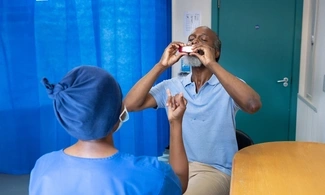Managing infective exacerbations of bronchiectasis
This page will help you to understand your role in supporting a patient with an exacerbation of bronchiectasis in primary care.
This is not a substitute for completing an appropriate respiratory assessment module. For advice and support on choosing the right course for you, please see our training and development page.
Quick recognition and treatment of an infective exacerbation of bronchiectasis is essential to prevent further damage to your patient’s airways.
Signs of an infective exacerbation
There is a change in one or more of the common symptoms:
- increase in the amount of sputum produced
- sputum changes colour or becomes thicker or smells offensive
- worsening breathlessness
- increased cough
- increased fatigue or feeling unwell
- fever, chest pain or haemoptysis.
Check and record their oxygen saturations, respiratory rate, heart rate and blood pressure. Assess your patient for signs of being unwell enough to need admission to hospital for intravenous antibiotics, for example cyanosis, confusion, difficulty breathing, peripheral oedema and fever above 38.8 degrees Celsius.
Make sure that any comorbidities are treated – for example a concurrent flare up of asthma or COPD.
Send a sputum sample to identify the organism that is causing the infection and start a 7 – 14 day empirical course of antibiotics as per NICE recommendations.
If your patient is already taking prophylactic antibiotics, ensure that they stop these whilst they are taking the new course.
Once the sputum culture and sensitivity result is available, the antibiotic can be changed if necessary.
Make sure that your patient knows that they must keep going with their airway clearance exercises whilst they are exacerbating. Refer them urgently to a respiratory physiotherapist for more advice if necessary, or if they need assistance to do their physiotherapy.
If they are very breathless, you can offer a trial of long-acting bronchodilator therapy, ensuring that they know how to use the device.
Make sure your patient knows to come back at any point if they feel they are getting worse or not improving. Reassess if symptoms worsen rapidly or significantly at any time, and consider:
- Other possible diagnoses, such as pneumonia.
- Any symptoms or signs suggesting a more serious illness or condition, such as cardiorespiratory failure or sepsis
Follow up after an exacerbation
Arrange a follow up appointment and talk to your patient about the exacerbation. See if you can identify any causes and see if you can take any steps to prevent another one.
For example, have they been
- finding it hard to keep to their physiotherapy routine
- exercising enough, or too much
- under any stress
- low in mood
- lost weight
- smoking or vaping
Work with your patient to identify any actions they can take to improve their overall health. Check that comorbidities are being managed appropriately.
Refer for additional physiotherapy or mental health support, or to the A+LUK helpline for a confidential chat. Refer for pulmonary rehabilitation if you haven’t done so already.
Identify any comorbidities and complications such as hypertension, atrial fibrillation, cor pulmonale, respiratory failure and malnutrition by recording their heart rate and rhythm, blood pressure, oxygen saturations, nutritional status and presence of peripheral oedema.
Consider referring your patient back to the specialist team in secondary care if
- you feel that they are deteriorating
- they have had 3 or more exacerbations in a 12 month period
- have symptoms that are not improving with repeated courses of oral antibiotics
- have bacteria in their sputum that are resistant to the available oral antibiotics, or
- they have newly identified pseudomonas aeruginosa in their sputum.
Review your patient’s self-management plan, and make sure they know what to do if they become unwell again.







